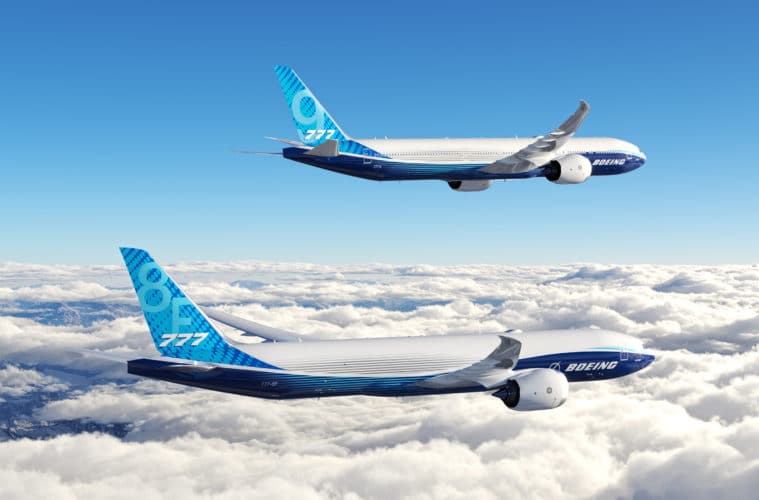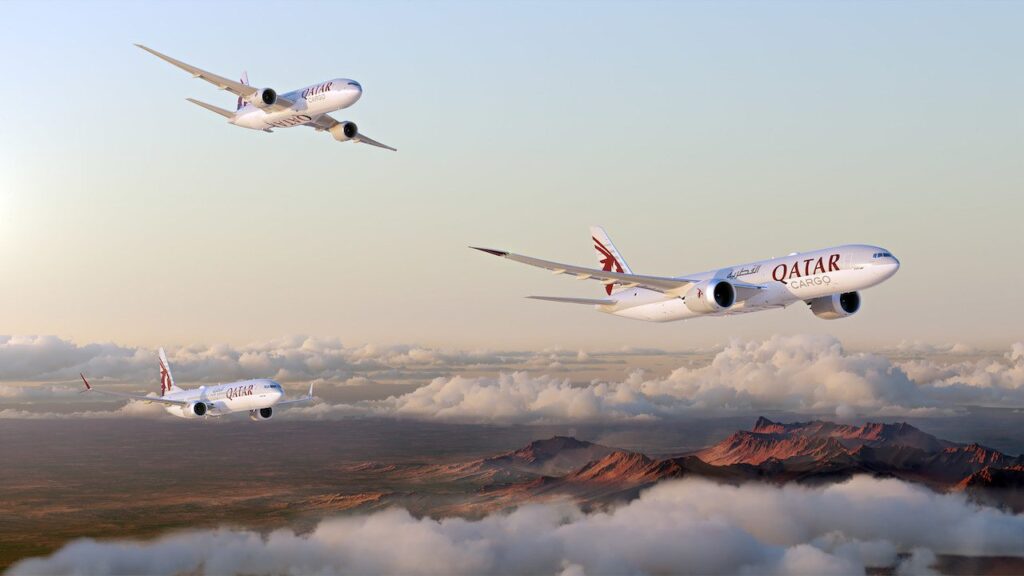Aviation
Boeing Launches 777-8 Freighter with Qatar Airways as Launch Customer

Boeing [NYSE: BA] today launched the new 777-8 Freighter and expanded its market-leading 777X and freighter families of jetliners with an order for up to 50 aircraft from one of the world’s largest cargo carriers, Qatar Airways..
Qatar Airways will be the 777-8 Freighter launch customer with a firm order for 34 jets and options for 16 more, a total purchase that would be worth more than $20 billion at current list prices and the largest freighter commitment in Boeing history by value. The order also supports hundreds of U.S. suppliers from across 38 states, will sustain more than 35,000 U.S. jobs, and provide the American economy with an annual estimated economic impact of $2.6 billion during the contract’s delivery period.
Featuring advanced technology from the new 777X family and the proven performance of the market-leading 777 Freighter, the 777-8 Freighter will be the largest, longest-range and most capable twin-engine freighter in the industry. With payload capacity nearly identical to the 747-400 Freighter and a 25% improvement in fuel efficiency, emissions and operating costs, the 777-8 Freighter will enable a more sustainable and profitable business for operators.
At the White House, Commerce Secretary Gina Raimondo, His Excellency Ambassador Sheikh Mishaal bin Hamad Al Thani, Director of the White House National Economic Council Brian Deese, and Boeing President and CEO Dave Calhoun joined the formal signing by Boeing Commercial Airplanes President and CEO Stan Deal and Qatar Airways Group Chief Executive, His Excellency Mr. Akbar Al Baker, who reaffirmed the airline’s commitment to the 777X family with the record-breaking 777-8 Freighter deal. First delivery of the new freighter is anticipated in 2027.
Qatar Airways and IndiGo Sign Codeshare Agreement
“Boeing has a long history of building market-leading freighter aircraft and Qatar Airways is honored to have the opportunity to be the launch customer for the 777-8 Freighter, an aircraft which will not only allow us to further enhance our product offering for our customers, but also help us meet our objectives to deliver a sustainable future for our business,” said Mr. Akbar Al Baker. “Today marks a great day in the ever-building and strong relationship between Qatar Airways and Boeing. We certainly push Boeing hard to deliver upon our expectations, and the team at Boeing consistently strives to meet and exceed our expectations, giving the opportunity for us to be here today to launch the most significant new freighter aircraft for a generation.”
Qatar Airways interested in Boeing 777X freighter version
“We are delighted to launch Boeing’s next great cargo airplane – the 777-8 Freighter – with Qatar Airways, one of the world’s largest cargo carriers and our partner since the airline began operations 25 years ago,” said Deal. “Our team is ready to create an airplane that will serve them well for many decades. Qatar Airways’ selection of the efficient 777-8 Freighter is a testament to our commitment to provide freighters with market-leading capacity, reliability and efficiency.”
Deal added, “We are proud that Boeing provides over 90% of the world’s dedicated freighter capacity. With global supply chains under pressure and high demand for e-commerce, the performance and capabilities of the fleet is more important than ever.”
Qatar and Airbus are embroiled in a dispute. What will happen next?
Boeing is designing the 777-8 Freighter, the newest member of the 777X family, to maximize efficiency and environmental performance. The widebody family features engineering design improvements and innovative technologies, including a new carbon-fiber composite wing and new fuel-efficient engines. With a range of 4,410 nautical miles (8,167 km), the 777-8 Freighter has a maximum structural payload of 118 tonnes, allowing customers to make fewer stops and reduce landing fees on long-haul routes.
Airbus cancels Qatar Airways’ A321neo order over the A350 dispute.
Boeing will build the 777-8 Freighter in its Everett, Wash., factory. The company has invested more than $1 billion into the Everett site to support 777X production and sustain thousands of local jobs for decades to come.
As part of today’s agreement, Qatar Airways will convert 20 of its 60 777X family orders to the 777-8 Freighter. Qatar Airways is also ordering two current 777 Freighters – Boeing’s best-selling freighter of all time – to capitalize on the buoyant air cargo market. Customers from around the world have ordered more than 300 777 Freighters since the program began in 2005.
Boeing and Qatar Airways also signed a Memorandum of Understanding for a firm order of 25 737-10 aircraft and purchase rights for 25 additional airplanes. The total value of this 737-10 commitment is nearly $7 billion at current list prices. The largest model in the MAX family, the 737-10 seats up to 230 passengers in a single-class configuration and can fly up to 3,300 miles. The fuel-efficient jet can cover 99% of single-aisle routes around the world.
“Qatar Airways very much looks forward to adding the 737-10 to its fleet, with this new variant of the 737 being ideally suited to our short-haul network, allowing us an opportunity to further enhance our product offering for our customers, modernize our fleet and operate the most efficient aircraft in its category,” said Akbar Al Baker.
“The largest member of the 737 family, the 737-10 is an airplane that offers more capacity, greater fuel efficiency and the best per-seat economics of any single-aisle airplane,” said Deal. “We are proud of our partnership with Qatar Airways and honored that this world-class airline continues to put its trust in our Boeing team.”
An international carrier with a passenger fleet including Boeing 777 and 787 Dreamliner airplanes and an all-Boeing cargo fleet of 747 and 777 freighters, Qatar Airways serves more than 140 key business and leisure destinations worldwide.

Aviation
Boeing, Antonov to Collaborate on Defense Projects

– MOU represents Boeing’s commitment to work with Ukrainian industry
– Includes exploring opportunities for collaborating on in-country support of Unmanned Aerial Systems
A Memorandum of Understanding was signed today by Boeing and Antonov Company to investigate potential collaboration on defense-related projects.
“We’re happy to keep collaborating with the Antonov Company to help Ukraine’s economic development and expansion,” stated Ted Colbert, CEO and president of Boeing Defence, Space, & Security.
Airbus and the Antonov An-225: The Best Partnership:Click here
“This agreement demonstrates our ongoing efforts to find more opportunities to work with Ukrainian industry, which was underscored by our signing of the Ukrainian Defence Industry Compact earlier this year.”
The areas of potential collaboration identified in the agreement consist of training, logistical support and overhaul services for tactical Unmanned Aerial Systems utilized by the Ukrainian Armed Forces, which includes the ScanEagle. In addition, the companies will also explore opportunities for Antonov to provide engineering support to Boeing.
The six largest cargo aircraft ever built in the aviation industry:Click here
“A strong, innovative, and efficient defense industry is key to sustainable economic development and national security, and we are extremely excited to collaborate with Boeing,” said Ievhen Gavrylov, CEO of Antonov Company.
This agreement brings a whole new level of opportunity to implement the latest and most effective solutions – in addition to the possibility of future projects with Boeing in the aerospace and defense industry.”
-

 Travel1 week ago
Travel1 week agoAir India to Expand US Operations with Three New Routes After a Decade
-

 Travel2 weeks ago
Travel2 weeks agoWhy We Should Avoid These Stamps in a Passport
-

 Airlines1 month ago
Airlines1 month agoInvestigations Reveal Fake Chinese Titanium in Boeing and Airbus Jets
-

 Tech4 weeks ago
Tech4 weeks agoChina’s CATL Plans 1,800-Mile Electric Plane Launch by 2027
-

 Airport3 days ago
Airport3 days agoTop 10 Largest Airports in the World by Size
-

 Aerospace4 weeks ago
Aerospace4 weeks agoChina’s Fighter Jets Turn Wings into Autonomous Drones
-

 Airlines4 days ago
Airlines4 days agoAir India Rolls Out A350s for Delhi-New York JFK and Newark Routes
-

 Defence3 weeks ago
Defence3 weeks agoBoeing Enhances Chinook with New Engines and Block II Upgrades at $96 Million








